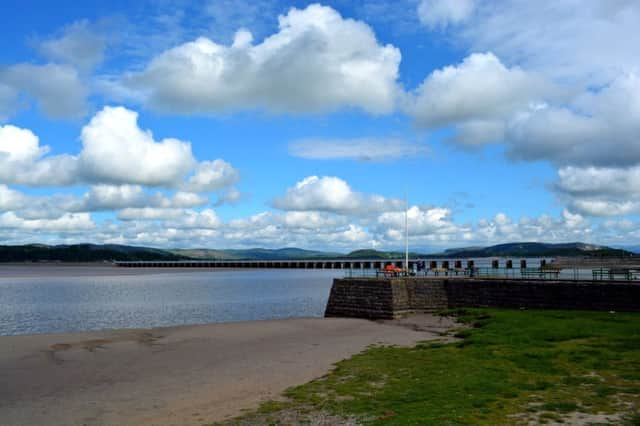Travel review - Discovering The Lake District without the madding crowds


How to choose between the Whitehaven fruit loaf, the Solway fruit cake and the Westmorland fruit pasty (with rum)? On a sunny Lake District morning, the Arnside Country Market is full of fruity temptation.
We’re browsing the stalls in the WI hall up a steepish hill in Arnside, a smart village at the top end of Morecambe Bay. It’s in the South Lakes area, sometimes described as “the Gateway to the Lake District”, which sells it rather short.
Advertisement
Hide AdAdvertisement
Hide AdEvery year, thousands of people drive past the road that leads down to Arnside, slavering for more familiar Lakes honeypots.
“Lots of people think of the Lake District as Windermere, Grasmere, Ambleside and Coniston,” says Lesley Hornsby, who runs Number 43, a luxury B&B in Arnside. “People who stay here in summer sometimes feel they’ve got to go to Windermere – it’s got the brand, hasn’t it?”
Number 43 has won numerous awards and is Michelin-listed. It’s an immaculately stylish Victorian town house with bright, elegant decor, decanters of sherry in the rooms and superb breakfasts.
And there’s Lesley herself, a sparky woman full of helpful advice and local knowledge about what she calls “this lovely pottering area”. As we arrive, she asks: “What are your plans?” We mumble vaguely. “Well, can I suggest...” she says and in three minutes she’s sorted out our next three days.
Advertisement
Hide AdAdvertisement
Hide AdFirst, though, the view from our bedroom window. Across the estuary where the River Kent meets Morecambe Bay, wooded slopes are backed by hazy mountains. The railway line round to Barrow crosses a long low viaduct over the water and trains make their steady way across, lit up like glow-worms at night.
Over to the left, Grange-over-Sands becomes a constellation of street lights as evening sets in. In the morning, water gradually covers the rippling, swirling sands, wading birds do what they do best (wade), and there’s an atmosphere of calm peace that can be hard to find in, say, crowd-jostling Ambleside on a Saturday afternoon.
Arnside is a perfect base for an alternative Lake District stay, with a short parade of shops including galleries, gift shops and an outstanding bakery. At its heart is the Albion, a convivial, unpretentious gastro-pub whose Lebanese platter is as satisfying a meal as we’ve had in years. All this in an Area of Outstanding Natural Beauty that attracts birders, walkers and people who wear woolly hats with bobbles.
After breakfast, we head for Grange, a genteel Edwardian-feeling resort, with another fine parade of shops under a wrought-iron colonnade. There’s a bandstand, a community orchard (every small town should have one), Gilbert and Sullivan shows, and a promenade offering an undemanding half-hour stroll, with views over the shimmering bay.
Advertisement
Hide AdAdvertisement
Hide AdThe town’s name may be a bit misleading, however. Even a century ago the Ward Lock Red Guide to the Lake District discreetly pointed out that Grange boasted “a wide stretch of sand not unmixed with mud”. Now it has a wide stretch of salt marsh, which makes the promenade feel rather like a country lane alongside lush fields.
We have a fine lunch surrounded by expensively dressed people at Rogan & Co, a Michelin-starred restaurant a few miles up the road in Cartmel. Its food is so exquisitely presented that it seems an act of sacrilege to eat it.
Cartmel is a particularly bijou – and popular – village centring on its huge and interesting Priory – “the most beautiful church in the North-West”, according to Simon Jenkins, the acknowledged arbiter of such things.
There’s a strong Lake District feel here. Not so in Kendal, the sturdy stone market town a few miles north, beyond Milnthorpe, where No 17 is a busy bar and restaurant serving challenging portions of full-flavoured food.
Advertisement
Hide AdAdvertisement
Hide AdKendal’s long main street is lined by 18th and 19th century “yards” – tight alleys, dark and rather secretive: Smokehouse Yard, Elephant Yard, Angel Yard – yard after yard of yards.
At one end is Abbot Hall, an uplifting art gallery with imaginative contemporary exhibitions and a collection including works by the fashionable 18th century portraitist George Romney, who painted Nelson’s Lady Hamilton more than 300 times. Less celebrated was John Harden, a friend of Constable whose intimate, informal watercolours of upper-class family life could be illustrations for Jane Austen novels.
Kendal’s most famous recent resident was probably Alfred Wainwright, borough treasurer and ramblers’ guru. He was honorary curator of the town’s engaging museum, where a case displays his stout-soled boots, pipe, leather-cuffed jacket, socks, rucksack, pens, camera and typewriter.
The town centre bustles pleasantly – particularly during the Mountain Festival, a major event in the climbing calendar. As a local man once told me: “Climbers meet on the slopes of Everest and say: ‘Are you going to Kendal this year?’”
Advertisement
Hide AdAdvertisement
Hide AdWe look in at Farrers Tea and Coffee House, which celebrates its bicentenary this year. The vintage tea canisters behind the counter hardly scratch the surface of the teas it stocks – Golden Monkey, Green Gunpowder, Jasmine Phoenix Pearls, Hibiscus Blossom, Assam Bop, Brazilian Yerba Mate.
Back at the Arnside Country Market, manager Sharon Moreton puts our trip in perspective. “We’re lucky to have access to the Lakes,” she says. “But we’ve got so much here.” We eventually settle for a Yorkshire curd tart.
GETTING THERE
Number 43, Arnside (01524 762119; www.no43.org.uk) has B&B doubles from £125. Further information about South Lakes breaks on Cumbria Tourism’s www.golakes.co.uk website.